Xiaomi Curved Gaming Monitor G34WQi review: A stand-out budget ultrawide

 Image: Matthew Smith / Foundry
Image: Matthew Smith / FoundryAt a glance
Expert’s Rating
Pros
Compact but effective ergonomic standExcellent contrast for a budget monitorStrong color performanceUp to 180Hz refresh rate with solid motion clarity
Cons
Stand requires some assemblyNo USB-A or speakersHDR is available but doesn’t impress
Our Verdict
Xiaomi’s G34WQi is a budget ultrawide with impressive image quality.
Best Prices Today: Xiaomi Curved Gaming Monitor G34WQi
RetailerPrice
Xiaomi is best known for smartphones (in North America, at least), but the company is making inroads into PCs with a handful of inexpensive laptops and monitors. The Xiaomi Curved Gaming Monitor G34WQi is the company’s latest budget ultrawide, and don’t let the price fool you: It’s an attractive display.
Xiaomi Curved Gaming Monitor G34WQi specs and features
The Xiaomi Curved Gaming Monitor G34WQi’s specifications are nearly identical to dozens of ultrawide monitors from competitive brands like Gigabyte, AOC, and Spectre (to name a few). It has a 34-inch Vertical Alignment (VA) panel with 3440×1440 resolution. Only the refresh rate stands out: It supports up to 180Hz, which is a tad higher than competitors at 120- to 160Hz.
Display size: 34-inch ultrawideNative resolution: 3440×1440Panel type: Semi-gloss curved VA-panel with LED backlightRefresh rate: Up to 180HzAdaptive sync: Adaptive Sync, AMD FreeSync PremiumPorts: 2x DisplayPort 1.4, 2x HDMI 2.0, 1x 3.5mm audio jackVESA mount: 75x75mmSpeakers: Yes, 2x 3-watt stereo speakersPrice: $289.99 MSRP, $260 typical online retail
The G34WQi carries an MSRP of just $289.99 and often receives a small discount off. That makes the G34WQi an alluring option, though it does face many similarly priced competitors.
Further reading: See our roundup of the best gaming monitors to learn about competing products.
Xiaomi Curved Gaming Monitor G34WQi design
The Xiaomi Curved Gaming Monitor G34WQi doesn’t make much of an impression out of the box. It’s clad in matte and semi-gloss black plastic that looks and feels fine but unexceptional. The only design highlight is the stand neck, which is svelte and has a piano black glossy finish to add a touch of class. An RGB-LED accent light is included, but it’s rather dim.
The monitor has an aggressive 1500R curve, meaning that the radius of the curve would be complete if the monitor were 1500mm wide. In other words, a smaller curvature number actually translates to a more aggressive curve. Most people will appreciate the immersion a curved screen can provide, but it slightly distorts the image (a straight line rendered across the display will appear curved, not straight), which could annoy content creators who need an accurate image.
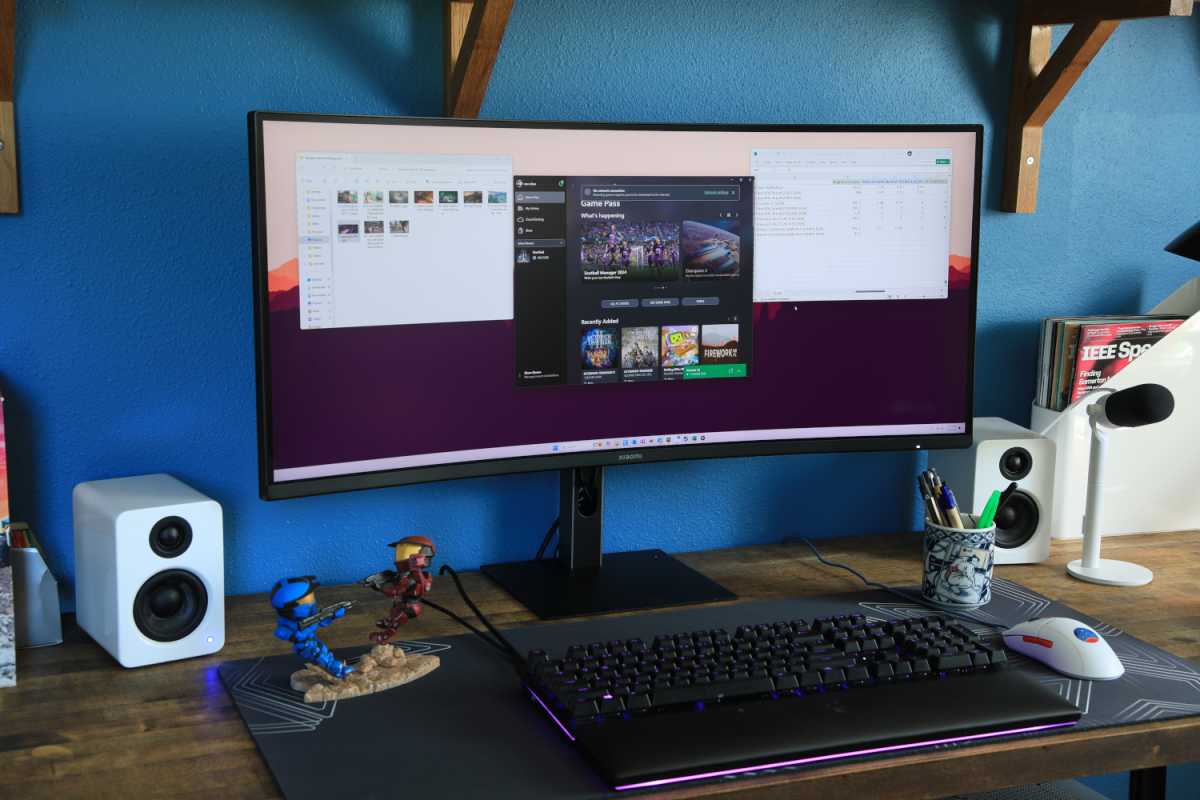
Matthew Smith / Foundry
Matthew Smith / Foundry
Matthew Smith / Foundry
A small, flat stand keeps the monitor secure on your desk and keeps the monitor’s footprint to a minimum. That’s important: Many budget ultrawides, like the Gigabyte GS34WQC, have oversized stands that take up a lot of desk space.
The stand provides adjustments for height, tilt, and swivel, and connects to the monitor with a 75x75mm VESA mount, allowing you to attach a third-party monitor stand or arm. The stand base doesn’t have a tool-less design though, so some assembly is required. A screwdriver is included, and assembly takes no more than two minutes, but more expensive monitors have a tool-free mechanism that’s easier to assemble and disassemble.
Xiaomi Curved Gaming Monitor G34WQi connectivity and menus
The Xiaomi Curved Gaming Monitor G34WQi’s connectivity is basic but expansive. It has two DisplayPort inputs and two HDMI inputs for a total of four video inputs, which is more than usual for a budget monitor.
However, the monitor lacks any form of USB connectivity, so it can’t be used as a USB hub to connect wired gaming peripherals. This is true for many budget ultrawide monitors, though most competitors with USB ports, like the LG 34BQ77QB, have a lower refresh rate or resolution. A 3.5mm audio out jack rounds out the connectivity.
The monitor’s on-screen menu system is controlled with a joystick located on the rear side of the lower right-hand bezel. It is responsive, easy to control, and navigates through Xiaomi’s well-labeled menus. The menus offer a fair bit of image quality customization, including several gamma presets that target specific numerical values, multiple color temperature presets, and settings for color hue and saturation.
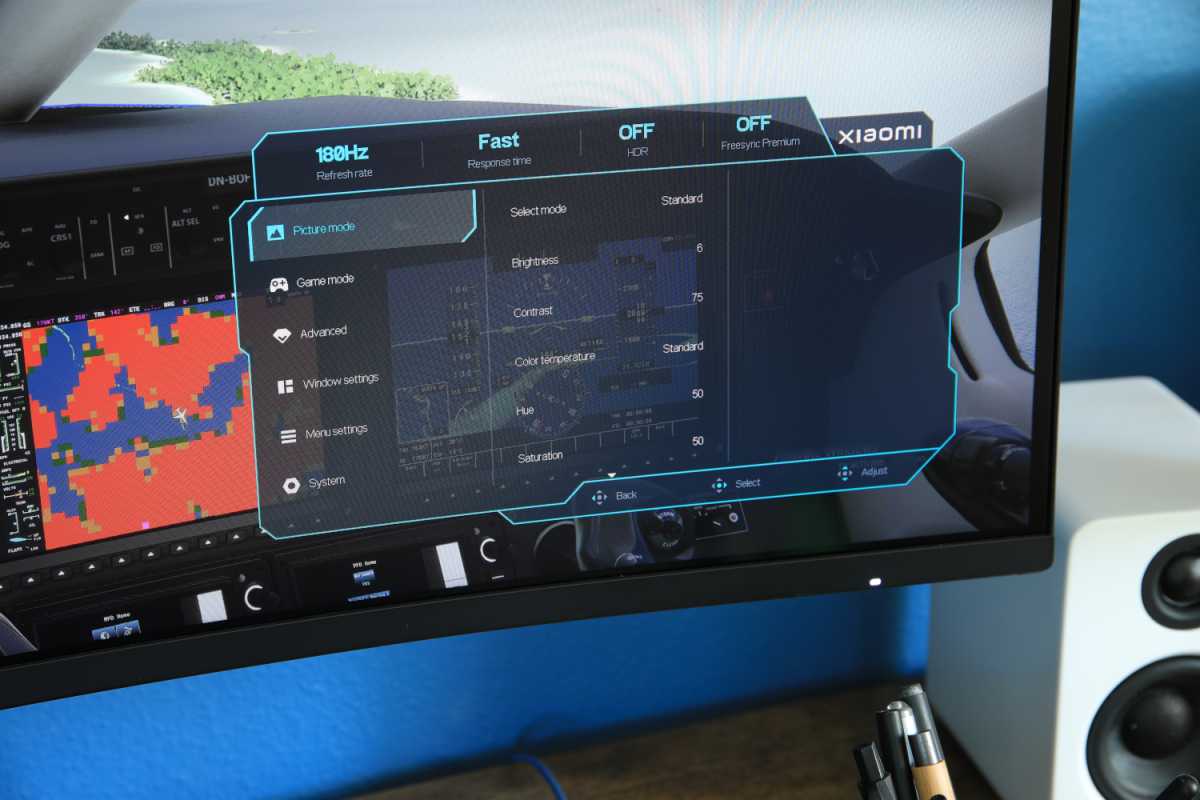
The Xiaomi Curved Gaming Monitor G34WQi‘s menu system is controlled by a joystick and easy to use.
The Xiaomi Curved Gaming Monitor G34WQi‘s menu system is controlled by a joystick and easy to use.
Matthew Smith / Foundry
The Xiaomi Curved Gaming Monitor G34WQi‘s menu system is controlled by a joystick and easy to use.
Matthew Smith / Foundry
Matthew Smith / Foundry
Strangely, the monitor has a separate set of image quality settings for the standard and game modes, which are adjusted independently. That can prove confusing as certain settings, like the monitor’s response time modes, can’t be changed without first activating game mode. On the plus side, this provides an easy way to calibrate the display’s settings differently for work and play.
Xiaomi throws in a few extra features, including several picture-by-picture modes and a black equalizer to elevate the black levels of the display and make enemies more visible in games. These features are appreciated but also available in most competitive monitors.
The monitor lacks speakers, so you’ll have to rely on external speakers or a headset. That’s typical for a budget ultrawide monitor. The few competitors that do offer built-in speakers deliver a sub-par experience that’ll quickly have you looking for an upgrade.
Xiaomi Curved Gaming Monitor G34WQi SDR image quality
The Xiaomi Curved Gaming Monitor G34WQi has a Vertical Alignment (VA) display panel paired with a conventional LED backlight. It’s a common combination for a budget ultrawide monitor, but effective, and the G34WQi’s SDR image quality holds up well.
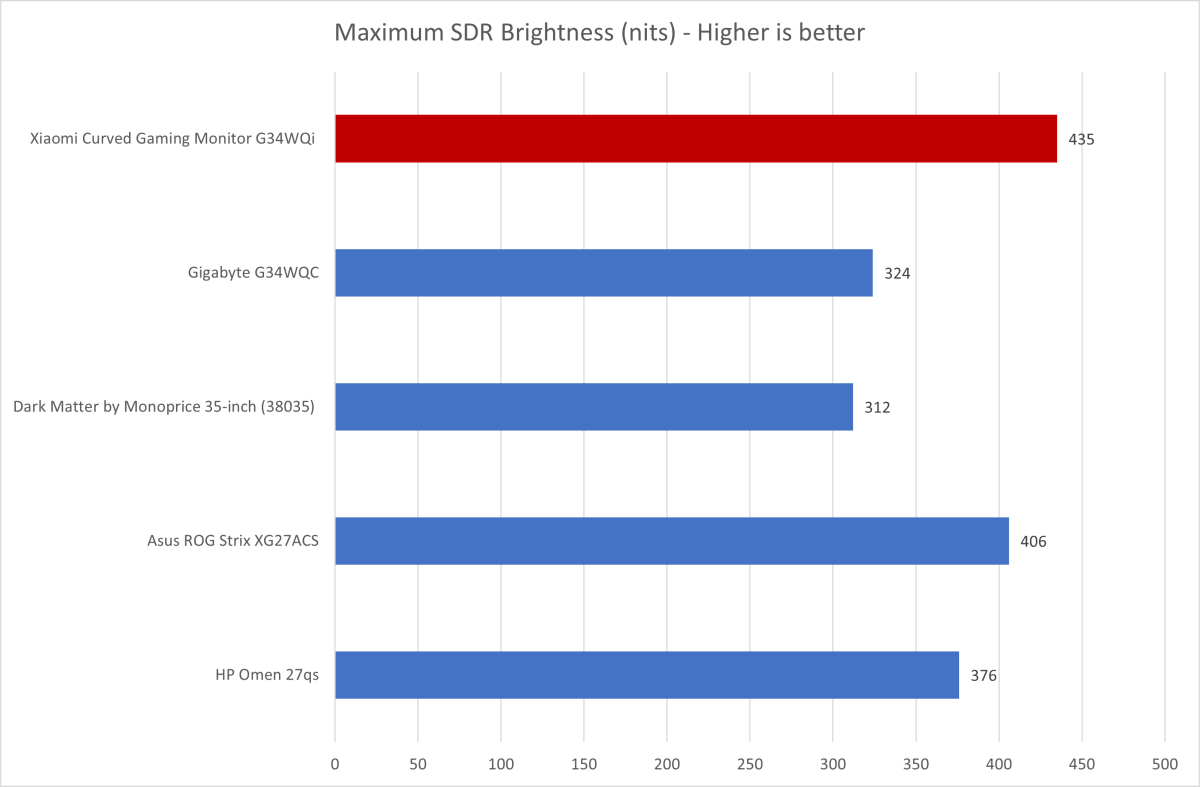
Matthew Smith / Foundry
Matthew Smith / Foundry
Matthew Smith / Foundry
Xiaomi scores a win in brightness, as the Curved Gaming Monitor G34WQi achieved a maximum sustained SDR brightness of 435 nits. That’s an excellent result for a budget monitor and beats many competitors by 25 or 30 percent.
A brightness of 435 nits isn’t required for typical use, of course, but it’s good news if you want to use the monitor in a brightly lit room or a room with sun-lit windows and poor light control. The G34WQi can easily compete with a room’s ambient light.
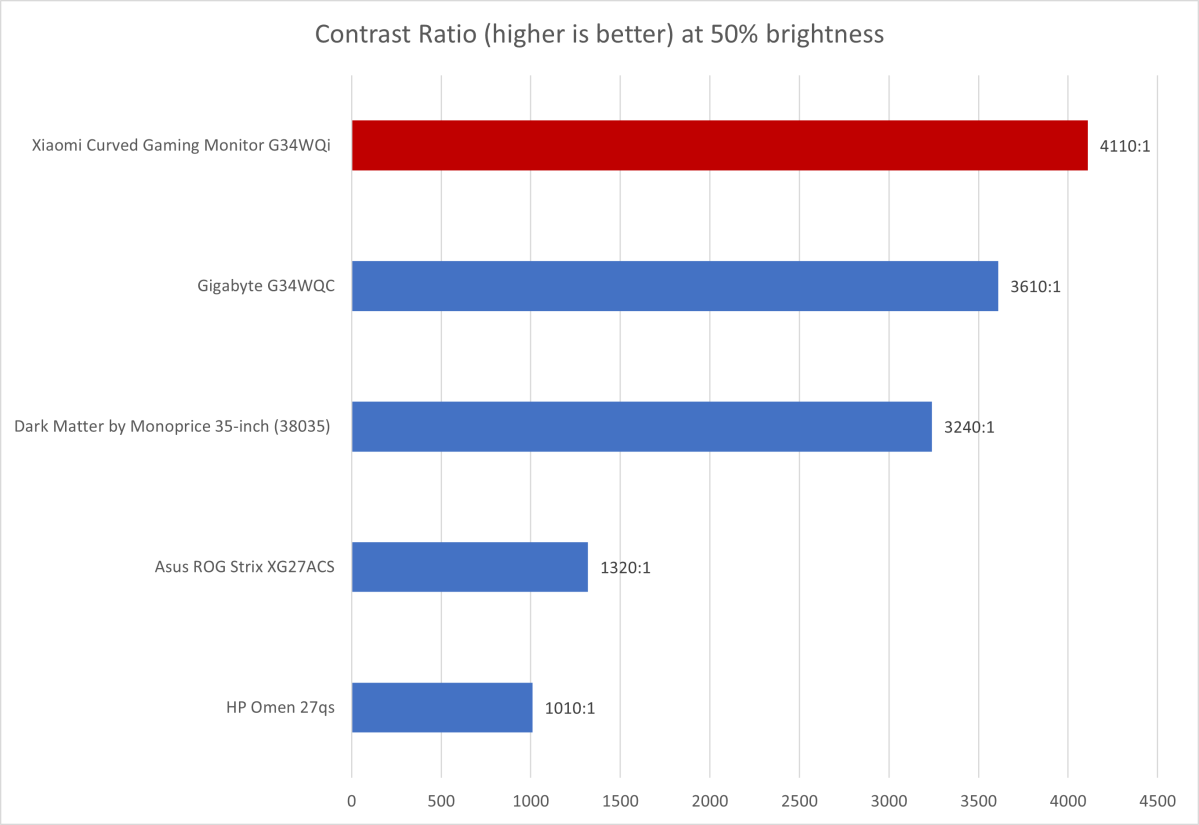
Matthew Smith / Foundry
Matthew Smith / Foundry
Matthew Smith / Foundry
Contrast is another win for the G34WQi. The monitor achieved a contrast ratio of 4110:1, which is towards the upper end of what’s available from a budget ultrawide with a VA panel, and much better than what’s available from monitors with an IPS panel (like the HP Omen 27qs and Asus ROG Strix XG27ACS).
A higher contrast ratio translates to an image with more depth and immersion. Bright content seems to pop from the display and darker content shows detail that might be obscured on a less capable display. The monitor’s minimum luminance isn’t perfect, so it can still appear a bit hazy or gray when viewed in a darkly lit room, but this is less noticeable than with most budget monitors.
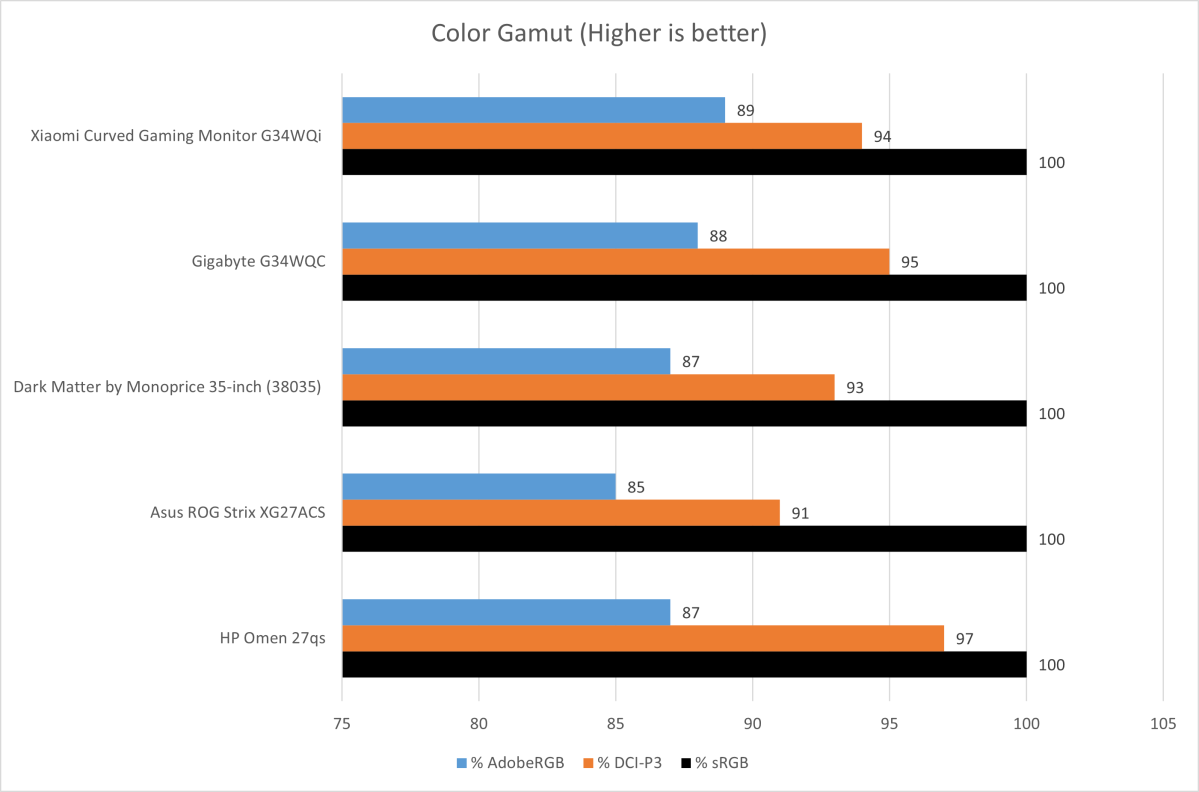
Matthew Smith / Foundry
Matthew Smith / Foundry
Matthew Smith / Foundry
The G34WQi posted another strong result with a color gamut that spans 100 percent of sRGB, 94 percent of DCI-P3, and 89 percent of AdobeRGB. These are excellent results for a budget display and more than enough to deliver a saturated, vivid image for gaming and Netflix. It’s also sufficient for many content creators.
With that said, the G34WQi ties competitors like the Gigabyte G34WQC. And some IPS panel monitors, like the HP 27qs, can provide a wider DCI-P3 color gamut. Xiaomi scores well here but it doesn’t stand out from the crowd.

Matthew Smith / Foundry
Matthew Smith / Foundry
Matthew Smith / Foundry
The same is true of color accuracy. The G34WQi’s color error is low enough that most people, myself included, won’t notice an issue. Videos, photos, and games look realistic and immersive. Still, the monitor’s out-of-box color accuracy is not remarkable and doesn’t beat competitors.
One problem I found noticeable was the monitor’s out-of-box color temperature of 7200K, which was significantly off the target of 6500K. The image seemed too cool and sterile when compared to that target. Color temperature can be adjusted with the monitor’s settings, and the ideal value can vary based on your preference. Still, 6500K is a common target, and most monitors come closer to it.
Gamma, on the other hand, was strong with an on-target gamma curve of 2.2. That means content viewed on the monitor generally looked as bright as it should and provided detail in both bright and dark areas. The curve can also be adjusted in the monitor’s settings, which is helpful for people who need (or prefer) a different gamma curve.
Sharpness was adequate. The G34WQi’s resolution of 3440×1440 works out to roughly 109 pixels per inch, which is identical to a 27-inch monitor with 2560×1440 resolution. Small fonts and high-contrast edges can appear slightly pixelated, and the Windows desktop lacks the absolute clarity of a 4K monitor, but it still looks rather sharp. Very few 34-inch ultrawide monitors offer a higher resolution, and those that do are much more expensive, so the G34WQi’s clarity is on par with its competition.
The Xiaomi Curved Gaming Monitor G34WQi’s SDR image quality is excellent for the price and competitive with some more expensive monitors, like the Asus ProArt PA348CGV. It also comes out a tad ahead of the Gigabyte G34WQC, another budget ultrawide I liked. Better monitors are available, of course, but you’d need to leap to a QD-OLED monitor like the Alienware AW3423DWF to see a massive improvement.
Xiaomi Curved Gaming Monitor G34WQi HDR image quality
The Xiaomi Curved Gaming Monitor G34WQi supports HDR but doesn’t list an official HDR certification (like VESA DisplayHDR 400). That’s just as well because, like most budget monitors, it fails to deliver a good HDR experience.
Brightness is part of the problem. The monitor’s maximum brightness of 435 nits in HDR is precisely the same as its maximum brightness in SDR. That’s not enough to do HDR content justice, and bright portions of a scene lack the detail available on more capable HDR monitors.
Contrast is also an issue. The G34WQi’s conventional LED backlight can’t increase brightness in any single portion of the display without increasing brightness across the entire display. As a result, HDR content will often show less depth than SDR, especially in scenes that combine a few bright highlights with a mostly dark background.
None of this is unexpected. Good HDR performance is out of reach for most budget monitors with the rare exception of new budget Mini-LED monitors like the AOC Q27G3XMN. Those looking for better HDR performance from an ultrawide will need to step up to an OLED or Mini-LED display.
Xiaomi Curved Gaming Monitor G34WQi motion performance
The Xiaomi Curved Gaming Monitor G34WQi’s specifications are promising. It has a maximum refresh rate of up to 180Hz and claims a minimum pixel response time of one millisecond. The benefits of these features were obvious when playing games. Quickly panning the camera revealed that significant detail remains visible and small, fast-moving objects are easy to see. It’s a huge upgrade from a 60Hz monitor.
With that said, gamers should keep the monitor’s price tag in mind. Motion clarity is good but nowhere near what’s available from more expensive displays. Competitive gamers who want great motion clarity at this price point should instead look towards 27-inch 240Hz widescreen monitors like the LG UltraGear 27GR38Q-B.
Adaptive Sync is supported for smooth, tear-free gaming, and the monitor is AMD FreeSync Premium certified (though only when connected over DisplayPort). Nvidia G-Sync should work with the monitor, as it’s compatible with Adaptive Sync, but the lack of official support means you’re out of luck if it doesn’t work as expected.
Should you buy the Xiaomi Curved Gaming Monitor G34WQi?
The Xiaomi Curved Gaming Monitor G34WQi is an outstanding budget ultrawide monitor that should work equally well for home office, gaming, and entry-level content creation. It provides strong contrast, a wide color gamut, high maximum brightness, and respectable motion clarity for less than $300.
Xiaomi faces a lot of competition, as many competitors sell ultrawide monitors with identical specifications at a similar price. Still, the G34WQi stands out in a few ways. It’s among the least expensive monitors, it has a compact yet functional ergonomic stand, it has four video inputs, and its maximum refresh rate of 180Hz is higher than most alternatives. These traits make the G34WQi a good choice, and it’s especially appealing when on sale for below MSRP.
Best Prices Today: Xiaomi Curved Gaming Monitor G34WQi
RetailerPrice
Author: Matthew S. Smith
Matthew S. Smith is a freelance technology journalist with 15 years of experience reviewing consumer electronics. In addition to PCWorld, his work can be found on Wired, Ars Technica, Digital Trends, Reviewed, IGN, and Lifewire. Matthew also covers AI and the metaverse for IEEE Spectrum and runs Computer Gaming Yesterday, a YouTube channel devoted to PC gaming history.
Recent stories by Matthew S. Smith:
Best monitor arms 2024: The ultimate in flexibilityBest 4K monitors 2024: HDR, 144Hz, budget, and best overallViewSonic XG272-2K-OLED review: A gaming monitor in a suit



